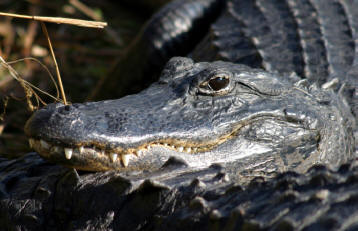
Adaptations
Home
Classification
Habitat/Geography
Adaptations
Nutrition/Diet Reproduction
Interactions
Interesting Facts
Credits
Modern alligators have many adaptations to make them
well suited for their wetland environment. These adaptations they have
acquired have made them the dominant predator in their entire region!
Skin-
Alligators skin is extremely tough. It needs to be to withstand the daily abuse they undergo because of things like thick vegetation, prey fighting to get away, the sun, and many other things. It is covered with large, strong, ossified, horny plates called osteoderms or scutes. These plates are extremely thick and well adapted for their environment. Their skin camouflages very well with their environment and along with the bulging eyes this makes them look like a log!
Teeth-
Alligators can have up to 80 teeth in their mouths at one time. These teeth are renewable throughout their life! Alligators can go through as many as 3,000 teeth in their lifetime! They lose teeth on a daily basis. Most of the time this happens when they are eating. When they attack an animal they clamp on to them they do not chew them. They shake their heads violently trying to kill the organism quickly. If its a bigger prey they will drag it under water and hold it there until it drowns. This process is extremely hard on their teeth; thus the reason they lose them while eating. Teeth grow right in place of the other ones when they are lost.
Webbed feet-
The gators back feet are webbed to help with steering in the water. This is part of the reason they are such fast swimmers. They combine the power of their tail with the efficiency of their webbed feet.
Anatomical positioning-
Alligators eyes, ears, and nostrils are all positioned on top of their head. When they are in the water they want to be as stealthy as possible so they keep the minimum amount of body out of the water as possible. This positioning makes it easier to breath, see, and hear. When the alligator submerges the eyes and nostrils close by reflex. Their eyes have a transparent third eyelid that covers the eye while the animal moves through the water. The alligators head has also become more massive through the years allowing it to have more momentum. This helps the alligator to get through heavily vegetated areas by smashing through it to catch prey.
Ability to hold breath-
Gators can hold their breath underwater for up to almost an hour! When they are not active or when the weather is colder they can hold it even longer! This allows them to wait for prey to come to them because they will not even know the gator is there.